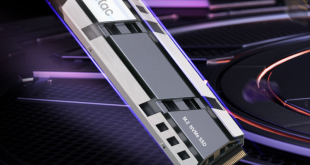Asus are world renowned for their class leading high end graphics cards and the Matrix HD7970 Platinum certainly has some remarkable features which qualify it for Republic Of Gamers status. The build quality of this card is absolutely flawless and matches the incredibly high standards set by Sapphire's HD7970 6GB Toxic Edition, released in July.
ASUS are very late to the game with the Matrix HD7970 Platinum and Sapphire have set such a high benchmark that we can't help but feel a little disappointed.
The Asus board is fully loaded with a substantial check list of overclocking extras. The card uses a 20 phase VRM which takes power from two 8 Pin PCIe power connectors. The company have incorporated a sophisticated load line calibration system with manual LLC factor control to help counter V Droop. It has an LN2 optimised BIOS and a substantial three slot cooling system with cooling plates on both the front and rear side of the PCB.
Why then did they opt for such a modest 1,100mhz core clock speed?
Regular readers will already have read our reviews of the 1,180mhz HIS 7970 X Turbo 3GB IceQ X2 and 1,200mhz Sapphire HD7970 6GB graphics cards, both of which are significantly faster ‘out of the box'.
I can appreciate ASUS catering for the hardcore overclocking audience who use Liquid Nitrogen, but I feel they have neglected the ‘general' high end enthusiast audience. This card should have had the BIOS tweaked to a 1,180mhz-1,200mhz clock speed, putting it in a head to head with the aforementioned market leaders.
The Matrix HD7970 Platinum may be better built than the HIS 7970X Turbo 3GB IceQ X2, but the Sapphire HD7970 6GB Toxic Edition is technically just as impressive.
The Sapphire HD7970 6GB Toxic Edition is louder than the Asus Matrix HD7970 Platinum, but it is also substantially faster, by simply hitting a button on the card which toggles the ‘Lethal Boost' bios.
ASUS don't offer a faster BIOS setting, but instead include a button for 100% fan speed. No gamer will want to run this card with both fans spinning at 100%, and those people who use Liquid Nitrogen will have removed the cooler and fans beforehand. It seems almost redundant in my opinion. The option for a 1,200mhz boost profile would have been a much better inclusion.
There is also the fact that ASUS have used a triple slot Republic of Gamers style Direct CU II cooler. This can make running Crossfire configurations rather difficult, depending on the motherboard. The Sapphire HD7970 6GB Toxic Edition is only dual slot and more compatible in multi card configurations.
In closing, I have no hesitation in recommending the Asus Matrix HD7970 Platinum graphics card. We have no confirmed store links at time of publication, although ASUS have informed us that the retail price will be around £450 inc vat. For £30 extra, I would personally buy the Sapphire HD7970 6GB Toxic Edition, it is faster and physically smaller, with double the onboard memory.
Pros:
- Fantastic build quality.
- Quietest ultra high performance HD7970 we have tested.
- Overclocks well with GPU Tweak.
- frame rate power is without question.
- Good Bundle.
Cons:
- The Sapphire HD7970 Toxic Edition is faster and has double the memory count which can help at 5760×1080+ resolutions.
- ASUS could have aimed for a 1,200mhz ‘out of the box' core clock.
- Triple slot cooler is bulky.
Kitguru says: A fantastic card from ASUS, but the Sapphire HD7970 Toxic Edition with Lethal Boost is still the fastest HD7970 on the market.
 KitGuru KitGuru.net – Tech News | Hardware News | Hardware Reviews | IOS | Mobile | Gaming | Graphics Cards
KitGuru KitGuru.net – Tech News | Hardware News | Hardware Reviews | IOS | Mobile | Gaming | Graphics Cards




Thats another beautiful card for AMD. Quite a few really high end, loaded boards for 7970 lovers.
Good review thanks.
ASUS deserve a lot of credit for this – I love it when companies go nuts on the design for the high end audience. Im tempted to go for this later in the year, but I agree – the Sapphire HD7970 6GB Toxic Edition looks to be a slightly better deal all round.
Zardon – top review bro. I still think the GTX680 is the best value for money high end card on the market however. you can pick up a killer one for £380
Im not a fan of triple slot coolers – I think in this case it has helped ASUS lower the noise levels which is welcomed, but they are huge cards and take up so much space in a case. I think Sapphire 6GB Toxic is still the best, but the extramemory really isn’t needed for most people/situations